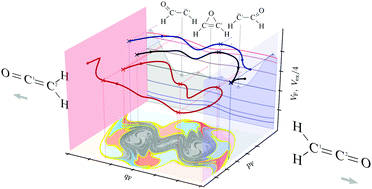Identifying reaction pathways in phase space via asymptotic trajectories†
Abstract
In this paper, we revisit the concepts of the reactivity map and the reactivity bands as an alternative to the use of perturbation theory for the determination of the phase space geometry of chemical reactions. We introduce a reformulated metric, called the asymptotic trajectory indicator, and an efficient algorithm to obtain reactivity boundaries. We demonstrate that this method has sufficient accuracy to reproduce phase space structures such as turnstiles for a 1D model of the isomerization of ketene in an external field. The asymptotic trajectory indicator can be applied to higher dimensional systems coupled to Langevin baths as we demonstrate for a 3D model of the isomerization of ketene.



 Please wait while we load your content...
Please wait while we load your content...